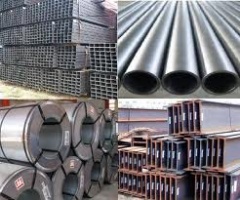Difference between revisions of "Iron and steel products"
| Line 36: | Line 36: | ||
| Precision strip, wire. Clean active surfaces, thin section products not tolerant of corrosion attack | | Precision strip, wire. Clean active surfaces, thin section products not tolerant of corrosion attack | ||
| Oil film, moisture resistant/inhibiting wrapping, coil or multiple coil containers | | Oil film, moisture resistant/inhibiting wrapping, coil or multiple coil containers | ||
| + | |- | ||
| + | | | ||
| + | | | ||
| + | |- | ||
| + | | Bright (reeled, peeled, turned, ground or drawn) bar and flat stock. Clean, active surfaces, possible oil coated during processing | ||
| + | | Oil or wax film, moisture resistant/inhibiting bundle wrapping and sleeving | ||
| + | |- | ||
| + | | | ||
| + | | | ||
| + | |- | ||
| + | | Machinery, machined components. Clean surfaces machined to fine tolerances | ||
| + | | Oil, grease or wax films, inhibiting wrapping, moisture resistant shrink cladding for pallets or lined crates | ||
|- | |- | ||
|}<br> | |}<br> | ||
Revision as of 13:57, 30 July 2013
| Infobox on Iron and steel products | |
|---|---|
| Example of Iron and steel products |  |
| Facts | |
| Origin | - |
| Stowage factor (in m3/t) | - |
| Humidity / moisture | - |
| Ventilation | - |
| Risk factors | See text |
Iron and steel products
Description / Risk factors
Iron and steel products
These products, broadly speaking, may be divided into two categories and they are:
a) material in the hot rolled condition which may be recognized as being blue/black in colour, which is the mill scale;
b) the cold rolled products which is the hot rolled product which has been cleaned of the mill scale and reduced in thickness by cold rolling, and this product is recognizable as being shiny and silver in colour.
In their hot rolled form most countries and industries accept that fresh water rust is not very detrimental to the product and this is because in nearly all applications hot rolled steel will be cleaned during or after fabrication. However, contact with sea water and certain other impurities, e.g. wet fertilizer, can be very detrimental inasmuch as by reason of its aggressive nature the surface of the material will become pitted and eroded.
Cold rolled steel, on the other hand, will become damaged by reason of contact with water in any form as same will readily rust.
Rust should be removed by a process compatible with the intended end use of the product. If acid-based pickling solutions are used, the surface must be adequately washed and neutralised after their application. Freshly cleaned steel surfaces will rust quickly unless protected by either a chemical or, more usually for temporary protection, with a suitable oil, grease or wax film.
Steel products may be protected from corrosion at the mill by a range of coating methods, prior to packing for shipment. These methods include, as the simplest, the application of oil films or primer coats of paint, and may include chemical surface conversion processes involving phosphating. In all cases there is a risk of rusting of the product if these applied films are damaged and penetrated.
The following table is a brief outline of the nature of steel products shipped and common ‘industry standard’ means of protection:
| Product and surface condition | Relative humidity |
| Steel sections and plates, with good 'mill finish' or cleaned and primed. | Prevention of direct moisture contact by e.g. sheeting. |
| Strip in coils, clean, active surfaces, possibly passivated | Moisture resistant coil wrapping, possibly oil firm |
| Precision strip, wire. Clean active surfaces, thin section products not tolerant of corrosion attack | Oil film, moisture resistant/inhibiting wrapping, coil or multiple coil containers |
| Bright (reeled, peeled, turned, ground or drawn) bar and flat stock. Clean, active surfaces, possible oil coated during processing | Oil or wax film, moisture resistant/inhibiting bundle wrapping and sleeving |
| Machinery, machined components. Clean surfaces machined to fine tolerances | Oil, grease or wax films, inhibiting wrapping, moisture resistant shrink cladding for pallets or lined crates |











